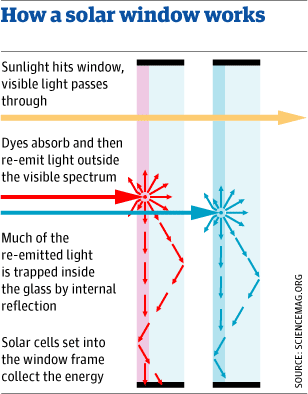Colourful Concentrators: Organic Solar
Posted by Big Gav in concentrating solar power, mit, organic dye, solar power, solar pv
Technology Review has an article on advanced organic dyes that more efficiently concentrate sunlight, which MIT researchers believe will reduce the cost of producing solar power - A Better Solar Collector.
Looking to make solar panels cheaper, MIT researchers have created sheets of glass coated with advanced organic dyes that more efficiently concentrate sunlight. The researchers, whose results appear in this week's issue of Science, say that the coated glass sheets could eventually make solar power as cheap as electricity from fossil fuels.
The researchers show that the glass sheets can reduce the amount of expensive semiconducting material needed in solar panels and provide a cheap way to extract more energy from high-energy photons, such as those at the blue end of the spectrum. "This could be the cheapest solar technology," says Marc Baldo, a professor of electrical engineering at MIT. "And I think one day, it could be competitive with coal."
The simple, flat sheets of glass have a number of advantages over previous solar concentrators, devices that gather sunlight over a large area and focus it onto a small solar cell that converts the light into electricity. Solar concentrators in use now employ mirrors or lenses to focus the light. Because the new glass sheets are lighter and flat, they can easily be incorporated into solar panels on roofs or building facades. They could also be used as windows, which, connected to solar cells, could generate electricity. What's more, mirrors and lenses require mechanical systems for tracking the sun to keep the light focused on a small solar cell. These tracking systems add cost and can break down over the decades that solar panels are made to be in service. The flat glass concentrators don't require a tracking system.
Instead of using optics, the glass sheets concentrate light using combinations of organic dyes specially designed by Baldo and his coworkers. Light is absorbed by the organic dyes coating one side of the glass sheet. The dyes then emit the light into the glass. The glass channels the light emitted by the dye to the edges of the glass, in the same way that fiber-optic cables channel light over long distances. Narrow solar cells laminated to the edges of the glass collect the light and convert it into electricity. The amount of light concentration depends on the size of the sheet--specifically, the ratio between the size of the surface of the glass and the edges. To a point, the greater the concentration, the less semiconductor material is needed, and the cheaper the solar power.
 The story has been reported in a lot of mainstream media outlets too, like this one at The Guardian - Dyes turn windows into powerful solar panels.
The story has been reported in a lot of mainstream media outlets too, like this one at The Guardian - Dyes turn windows into powerful solar panels.Windows could be used as powerful solar panels thanks to a clever new technology that concentrates the sun's rays. The technique uses transparent dyes to capture, concentrate and redirect light along the surface of the glass to photovoltaic (PV) cells in the frame, which convert the light into electricity. The breakthrough means that there is a tenfold increase in power output compared to use of the PV cell alone.
The team, from the Massachusetts Institute of Technology (MIT), claims the technology could slash the cost of generating electricity from sunlight, making it more competitive with standard grid power. This is because the expensive PV cells only need to be installed at the sides of the panels, rather than across the whole surface.
Sunlight is concentrated in existing solar power devices using large, mobile mirrors that track the sun as it moves across the sky. But these can be expensive to deploy and maintain. In the MIT device, called an "organic solar concentrator" and described in the latest issue of Science, the researchers painted a mixture of organic dyes onto the surface of a pane of glass. The dyes trap different wavelengths of sunlight and then guide the energy along the glass towards the PV cells at the edges.
"The point of all this is to get away with using far fewer solar cells," said Marc Baldo, an electrical engineer at MIT. "The concentrator collects light over its whole front surface, but the solar cells need only cover the area of the edges."
As the edges of a glass panel can often be 100 times smaller in area than the surface itself, he added, solar panels would need 100 times fewer PV cells to collect the same energy. "So we can save money. Since industry can't produce enough solar cells to satisfy demand, this might also be a good way to stretch production." ...
Greenpeace's chief scientist, Doug Parr, said: "Innovations like this show renewable technologies can take a quantum leap forward if given proper financial support from governments. Rather than betting the farm on outdated nuclear technology and hoping that coal will one day be 'clean', Gordon Brown should be creating green jobs and pushing at the real technological frontier of the 21st century - renewables."
Continuing the solar theme, the San Francisco Chronicle reports the biggest U.S. photovoltaic power plant is to b built in Florida.
SunPower Corp. of San Jose will announce plans today to build the country's largest photovoltaic solar power plant in Florida. Unlike most large-scale solar plants, which use big mirrors to concentrate sunlight, the SunPower project will use the same solar panels that homeowners install on their rooftops.
It will be built in Florida's DeSoto County and will generate up to 25 megawatts of electricity, enough to power 18,750 homes. SunPower also will build a smaller facility, generating 10 megawatts, at Kennedy Space Center.





